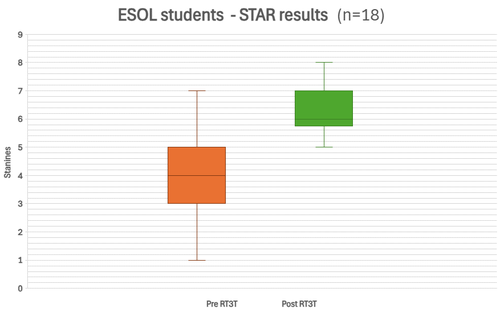Exceptional results in two small schools with deeply committed leadership.
Ann Maree Molloy, Glendene Principal
This has been a great collaboration.
Our teachers were already aware of the proven value of reciprocal learning, and were enthusiastic and committed to all aspects of this professional development. They quickly observed that RT3TTM was highly engaging for our learners as well as creating many learning opportunities. They described how RT3TTM enabled students to draw on their strengths, share whānau knowledge, and more actively communicate across a range of authentic contexts from the Glendene Curriculum. Teachers saw students growing in confidence, and students reflected on how they enjoyed feeling clever and more capable.
As a school, we were excited about the remarkable achievement results and expect RT3TTM to become an embedded teaching practice.
Thank you.
Two small schools, Glendene and Korakonui, commenced RT3TTM PLD in 2024, and their senior leaders were enthusiastically supportive throughout.
Glendene School is a small school in West Auckland with 81% of their students identified as speaking languages other than English at home (including 41% of students who qualify for ESOL funding), and a high level of transiency.

After the initial RT3TTM PLD, senior leaders and teachers at Glendene were very excited with the progress made by their students, and especially with the gains made by their students receiving ESOL funding. The percentage of these students achieving at and above expected levels had shifted from 42% to 77%, see the box and whisker graph.
Korakonui School is a rural full primary school in South Waikato. Their current roll is just under 200 children. Students are predominantly Pākehā, with about 20% Māori and other ethnicities.
Towards the end of their first year of RT3TTM PLD, the Year 4-8 teachers and TAs observed and recorded improvements in their children’s leadership, teamwork and communication skills, and in the way children supported and encouraged each other in their learning.

Teachers did not expect that their students would have such impressive results on asTTle Reading. The percentage of students at or above expected levels increased from 23% to 43%, with consistency across Year levels. The scores on asTTle Deep Thinking showed the most marked gains. See the second graph above. One student with autism made a shift of 5 sublevels, from 2P to 4B.
While these two small schools serve quite different communities, their results illustrate that with committed leadership and teachers, and highly skilled facilitators, the impact of RT3TTM is significant for our learners, teachers and leaders.
For more on results with primary and intermediate schools, visit: https://rteach.co.nz/rt3t/rt3t-results-in-schools


